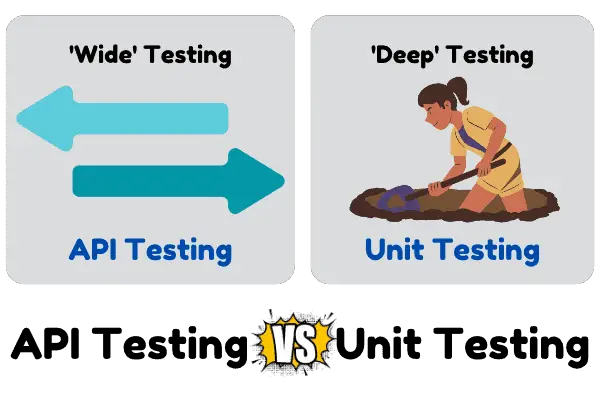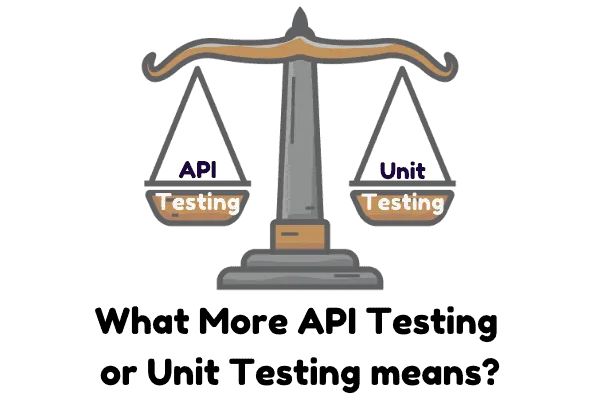
I. Introduction
In the enchanting realm of software development, testing weaves its magic, casting a spell of quality, reliability, and performance over the applications that captivate our digital experiences. Two key testing types are API Testing and Unit Testing, each with its unique purpose and approach. In this comprehensive comparison and guide, we will explore the differences and best practices for both testing types, enabling you to make informed decisions in your testing strategy.
What is The Difference Between API Testing and Unit Testing?
If you have ever wondered what is API Testing Vs Unit Testing; we have the table below that should clarify the differences.
| Factors | API Testing | Unit Testing |
|---|---|---|
| Scope and Granularity | Focuses on interfaces, interactions, and data exchange between components | Concentrates on individual functions or methods, and their internal logic |
| Test Execution and Dependencies | Requires running application and may depend on external systems | Tests components in isolation, generally without dependencies on external systems |
| Test Case Design and Automation | Validates requests, responses, and data formats exchanged between components | Identifies inputs, expected outputs, and edge cases for each test scenario |
| Performance, Security, and Usability | Validates system functionality, performance, security, and usability | Focuses on functional correctness of individual components |
| Impact of Biased focus | Ensures overall functionality, uncovers data format, security, and performance issues | Leads to stable and maintainable code, prevents error propagation |
| Impact of Bias (Cons) | Inadequate attention to individual components, slower and complex test execution | Inadequate testing of overall system functionality, misses end-to-end scenarios |
| Value in Test Strategy | Provides a ‘width’ of coverage (helps cover a lot of functionality) across the application. | Provides a ‘depth’ of coverage (helps test a given component’s possible use case combinations quickly) across the application. |
There are obvious nuances in addition to these differences, read on to understand more in details and how you can optimize your test strategies to ensure the right balance.
II. API Testing and Unit Testing Fundamentals
- API Testing: API Testing involves validating the functionality, performance, and security of Application Programming Interfaces (APIs) to ensure seamless integration between software components. For an in-depth understanding of APIs, refer to this introduction to APIs. Some common use cases for API testing include verifying data formats, response times, and authentication mechanisms.
- Unit Testing: Unit Testing focuses on testing individual units or components of the software, such as functions, classes, or methods. The goal is to identify and fix issues at the smallest level of the code to improve maintainability and stability. Unit testing examples include checking whether a function returns the expected output or whether a class correctly initializes its properties.
III. Comparing API Testing and Unit Testing
- Scope and Granularity
API Testing targets the interfaces between software components, validating their interactions, and data exchange. It focuses on overall functionality and behavior, ensuring that the communication between different parts of the system is functioning as expected. In contrast, Unit Testing examines isolated code elements, ensuring that each component works correctly and independently. Unit tests concentrate on the internal logic and output of individual functions or methods.
- Test Execution and Dependencies
API Testing often requires a running application and interactions with external systems or databases, making it more dependent on the availability and stability of these resources. This dependency can impact the test execution time and may introduce additional complexity in the testing process. Unit Testing, however, operates on a more isolated level and generally does not depend on external systems, making the test execution faster and more reliable.
- Test Case Design and Automation
Test case design for API Testing focuses on the requests, responses, and data formats exchanged between the components. It includes validating headers, response codes, and data structure. For an in-depth understanding of API test design, refer to this comprehensive guide. In contrast, Unit Testing test case design involves identifying inputs, expected outputs, and edge cases for each test scenario.
Test automation is crucial for both API and Unit Testing to improve efficiency and reduce human error. The choice of tools and frameworks differs based on the testing type. For example, Postman, SoapUI, and JMeter are popular for API testing, while JUnit, NUnit, and Mocha are widely used for unit testing.
- Performance, Security, and Usability
API Testing allows you to validate the performance, security, and usability of an application. It helps identify bottlenecks, security vulnerabilities, and user experience issues, which may not be detected through unit testing alone. On the other hand, Unit Testing focuses more on the functional correctness of individual components, ensuring that they produce the expected outputs for given inputs.
IV. Pros and Cons of API Testing and Unit Testing

- Impact of a Bias Towards API Testing
- Pros: Focusing on API Testing ensures that the interactions between components work as expected, which is crucial for the overall functionality of the application. It can uncover issues related to data formats, security, and performance that may not be detected by unit testing alone. By simulating real-world scenarios, API testing can help identify potential user experience problems.
- Cons: Overemphasizing API Testing may lead to inadequate attention to the correctness and stability of individual code components, increasing the risk of bugs and making the application harder to maintain. API tests can also be slower and more complex to execute due to dependencies on external systems.
- Impact of a Bias Towards Unit Testing
- Pros: Concentrating on Unit Testing can lead to more stable and maintainable code, as it focuses on testing individual components in isolation. By catching issues at the code level, unit tests can prevent errors from propagating to other parts of the system, reducing the overall defect rate.
- Cons: Overemphasis on Unit Testing may result in inadequate testing of the overall system functionality and integration between components. Unit tests cannot verify end-to-end scenarios or identify issues related to performance, security, and usability, potentially leading to a lower-quality user experience.
To achieve a balanced approach that ensures comprehensive test coverage, it is essential to combine both API and Unit Testing in your testing strategy. Understanding their unique advantages and limitations will enable you to allocate testing resources effectively and address the specific needs of your projects. By leveraging the strengths of both testing types, you can ensure that your applications meet the highest standards of performance, security, and usability.
V. Balancing API Testing and Unit Testing
- Determining the Right Mix Deciding on the optimal testing strategy depends on factors such as project requirements, team expertise, and budget constraints. A balanced approach that combines both API and unit testing ensures comprehensive test coverage and catches issues that may be missed by focusing on a single testing type.
- Best Practices for Combining API and Unit Testing
- Ensuring comprehensive test coverage: Identify areas where both API and unit testing can complement each other to maximize test coverage. For more insights on maximizing API test coverage, explore this article.
- Prioritizing testing efforts based on risk and impact: Focus on high-risk components and critical functionality, allocating testing resources accordingly.
- Leveraging the strengths of both testing types: Utilize the unique advantages of API and unit testing to create a robust testing strategy. This guide to tackling common API testing challenges provides valuable tips for overcoming obstacles in API testing.
VI. Conclusion
API Testing and Unit Testing both play crucial roles in ensuring software quality and reliability. Understanding their key differences, pros and cons, and the impact of bias towards one over the other will help you develop a balanced testing strategy that addresses the unique needs of your projects. By combining the strengths of both testing types, you can ensure comprehensive test coverage, catch issues early in the development process, and deliver applications that meet the highest standards of performance, security, and usability.

